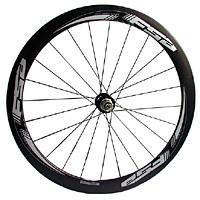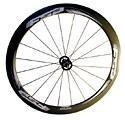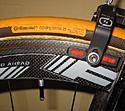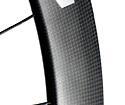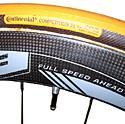
Recently on Cyclingnews.com |
On test: FSA RD488 wheels, May 27, 2005Carbon tubulars for the peopleFSA's deep-rim carbon wheels have Dave Langley reliving his tubular-shod youth - and loving it.
Back when I used to be super-keen about my racing I had a special pair of race wheels purely for the open road events. The wheels were invariably tubulars (aka "singles" or "sew-ups"), in which the wafer-thin race tire is glued to a light rim whose cross-section provides little more than a depression where the tire sits. Such wheels were light, fast and super comfortable. I'd almost forgotten the sensation of floating on tubulars until I was handed this pair of FSA-RD488 carbon wheels to review. Why bother with tubulars?Today's youth might wonder why tubulars were ever popular. Many might not have even seen them, let alone raced on them. Before the clincher evolved into what it is today, the lightest rims available were of simple box cross section with no raised hook for a clincher bead. Whilst such wheels were lighter than their clincher cousins, a claim which no longer necessarily holds true, they certainly still provide a more cushioned ride for a given tire pressure. My own explanation for this is that the absence of the restrictive clincher wall allows greater compression when the tire hits an object. This also correlates with far fewer "pinch flat" or "snake bite" punctures caused by violent compression onto the clincher walls. In fact, at the elite end of the sport, road and track, tubulars are still the wheels of choice, especially for cobbled courses (such as Paris-Roubaix) or time trials. And whilst they certainly require more effort to install and maintain, such angst is generally handled by the team mechanics rather than by the riders themselves. The wheels
But while some digression on the subject of tires is unavoidable, we're supposed to be looking at the FSA RD488 wheels here. These are intended as fairly lightweight, aero wheels for all-round racing use - not so light that they have to be handled with kid gloves, but at 1465g for the pair (without skewers) they're no boat anchors. Both front and rear hubs are of a retro-style high flange design, where the flange wall itself is drilled out and rides effectively on four uber-spokes. Great look. The front wheel has 20 radially laced spokes whilst the rear has 24, radial on the non-drive side and 2-cross on the drive side. The spokes themselves are of thin gauge [gauge?] yet bladed for most of their exposed length. As the nipples are hidden from view inside the rim walls, the tire would have to be removed should a spoke need to be replaced or the wheel re-trued. I've not used FSA skewers before, but I particularly like the look and functionality of the set supplied. The rims themselves are without doubt the deepest profile rims I have ridden (5 cm from outside to inside edge). The hub-side section is somewhat compressible when squeezed and no doubt is acting primarily as a fairing. The tire side is rock hard as befits the part which presumably is responsible for the structural integrity of the wheel. There is more than ample hard stuff to act as the breaking surface for carbon pads. The overall finish looks superb - really eye-catching and bound to add considerable sparkle to whatever frame they are attached to. One impressive-looking set of wheels!
Our test wheels were shod with Continental Competition 25 tubulars and fitted to my early 90s Columbus EL Colnago (yep, steel - what can I say, I'm a traditionalist). The running gear is mostly nine-speed Shimano Ultegra from 2000 and for this test we threw on a pair of Zero Gravity brakes with Corima cork pads to match the carbon fiber rims. Mounting the tiresThis proved to be more involved than was expected due to the combination of rim and tire I was trying to mesh. The tires provided for the test were Continental Competition 25's, basically the same tires used by several teams at this years Paris-Roubaix. These tires have short valve stems. The rims have a very deep profile. In the simplest scenario (although probably not the soundest method), once the tire is mounted, a value extender could be inserted into the rim hole, threaded onto the valve, the tire inflated, and the valve extender removed. However, with these rims the narrowness of the rim hole prevented either brand of valve-extender I owned from entering.
Hence, not only did the thinnest of the extenders i could get my hands on (Zipp) have to be filed down in two places (the phalic "head", which gets squeezed into the pump, and the mid-shaft, which progressively fattens towards the threaded end), the modified extender had to be fixed to the tire before it was mounted. Pre-fixing the extender is actually not such a bad idea, as it allows one to get a really nice seal with judicious use of plumber's Teflon tape around the valve thread. With a good valve-extender to valve seal, you can put some serious pressure into the tires. Not wanting to weaken the valve extender by filing its middle too thin, I also very judiciously widened the carbon valve hole by a fraction of a millimetre with a fine curved file. Additionally, I fractionally widened the valve hole on the tire-side of the rim to allow the tire at the valve stem to sit perfectly centered. (The valves on tubs, although close to being centered with respect to the stitched seam, are usually not perfectly centered. Even if only 1 mm out, such displacement is exaggerated by a tight rim hole, forcing the tire to sit asymmetrically at the valve, which is not what you want!) I'm sure such practice would not be condoned by FSA, but there was simply no other way I could get the combination of tire, rim and extender to mesh nicely. Presumably most of this fiddling can be avoided by choosing long-valve tubulars in the first place. Regardless, I suspect the valve holes could be drilled fractionally wider without significantly compromising the strength of the wheel, making them more versatile with regards tire choice. This can be particularly important if one punctures out training, God forbid, and has to make do with a spare which is not necessarily custom modified for the wheel in question. As for the mounting itself, I'll spare you a detailed explanation, but if you've not done it before, nothing can prepare you for the finger breaking experience of muscling tire onto rim where both are generously coated with partially dry contact adhesive. It's like pulling teeth, but having steeled oneself after the first wheel, in my experience the second normally goes on easier, and it thankfully did here. Once mounted, trued (more thumb and finger calisthenics) and inflated, there's nothing left but to wipe the sweat from your brow, relax sore head and hands with a beer or three whilst contemplating whether tubulars are worth all this bloody hassle, and wait till the next morning for the glue to cure before heading out. ZZZzzzzzzz... (the crowd goes wild as Langley drops Armstrong and Co on the Col de la ...} The ResultRolling out on these wheels for the first time was an exciting experience. The unique carbon rolling sound and clunkyness of the gear changes at first makes you think the wheels are egg-shell fragile. Once you gain the confidence to stomp, however, you are quickly assured by the realisation that you are riding on a very fine set of high-end wheels. These things are great - undoubtedly the flashest wheels I've ridden. Noise
If you've not ridden carbon wheels before you are in for a new experience. When on top of the gear on a nice flat stretch of road the revolving wheels make an unusual yet sublime "whishing" sound akin to sharpening a fine blade on a whetstone. Accompanied by such a delicate sound you feel that you are really motoring on a very fine piece of machinery. Ain't the bicycle glorious! Stop pedalling though and that wonderful sound is drowned out by a fairly noisy freewheel, whose clicking in the big chamber provided by all that enclosed carbon. The faster, the louder the freewheel racket. Unfortunately, if the road is less than perfect (most roads in Sydney), every ripple and corrugation results in wheel chatter, both front and back. On a dead road, the wheels have a conversation all to themselves. Whilst there is normally enough for me to concentrate on not to get distracted by the noise, riding companions did comment on numerous occasions as to the noisiness of the wheels. In one instance I was not able to surprise a mate I was reeling in near the top of a climb. He heard the wheels from way back! So, stealth wheels these ain't, but from my observation noisiness is something shared by most carbon wheels. WindAs might be expected from wheels with such a sail area, when riding in a heavy cross-wind, one can feel more of a tug than would normally be expected. This can be unnerving when descending at speed through terrain which gets buffeted by air coming from various directions, but is par for the course. Having said that, the heavier handling in windy conditions is something that one gets used to fairly quickly. TiresFor general purpose racing, as was the set up in this case, the Continental Competition 25s are an excellent option, providing a good compromise between low rolling resistance and comfort, which was exceptional. A narrower, lighter tire, such as the Continental Tempo, would be an ideal choice if you wanted to use the RD488's exclusively for time trials on good surfaces. BrakingAnother reason why such wheels are reserved for serious training/racing, as opposed to commuting, is the reduced braking efficiency resulting from cork pads on a carbon surface. Increasing pressure on the brakes doesn't have much effect till it really starts to grab the wheel in rhythmic spurts. All together carbon and cork is not a great combination, even though it's better than the terrifyingly useless combination of carbon rims and standard rubber pads. Although swapping brake shoes is a bit of a business when alternating between training and racing wheels, the judicious use of some light oil on the back of the brake pads takes the pain out such transitions (but be sure to keep oil off the wheel surface!) Punctures
Riding tubulars does make one paranoid about glass, and I found myself cleaning the tires on the move frequently. This is not such a bad idea anyway, as punctures are ultimately a pain, even if you are riding clinchers. The only down side is that you'll go though your riding gloves faster than otherwise. Fortunately, after 500 km of Sydney's rubbish-strewn roads I was very relieved to be able to hand the wheels back in good condition without suffering the inconvenience of a puncture. The 500km verdictThe riding done with these wheels was split evenly between commuting and trying to outwit/muscle cycling mates on longer weekend rides and training-bunch gallops. Having now clocked over 500 km on these wheels, their presentation still looks A1 and the rims are still perfectly true, in spite of Sydney's less than ideal roads. I should state that as well as being probably the fastest wheels I've used, they are also close to the most comfortable, due both to the fact that they are tubulars, and due to the tire choice used for this test (Conti Competition 25's at approx 100 to 110psi). These wheels are not for everyone. Although mounting tubs is generally not as involved as was the case here, it is still a bit of a business reserved for those who really do love to compete... the type who eat, drink and sleep cycling. As to whether it is worth it? That's a very personal question which goes to the core of how mad about the sport you are, and your disposable income, and is further tempered by whether you've got enough time to be willing to make the extra effort to set up and maintain such wheels. For me, those days as a serious amateur have passed, but for the keen whippersnappers out there, the RD488's are an excellent option as a set of general purpose race wheels or time trial aces. Suggested retail price: |
||||||

